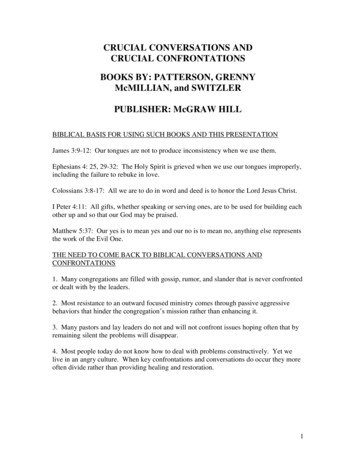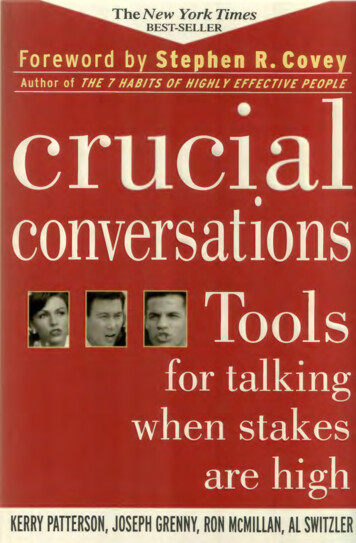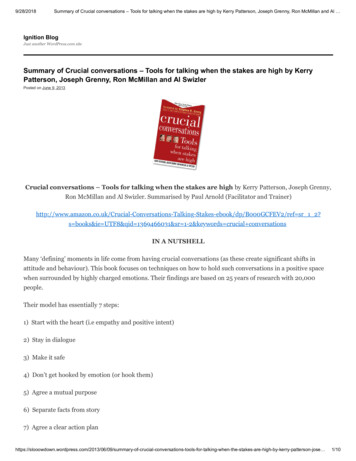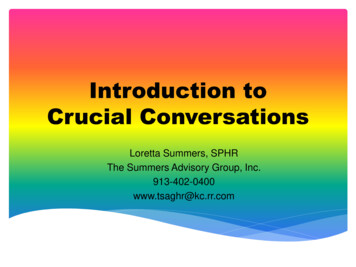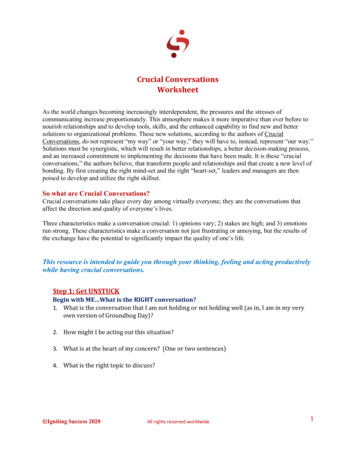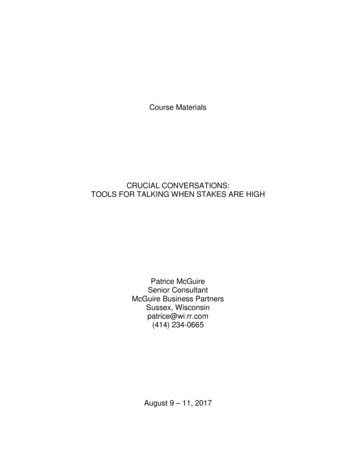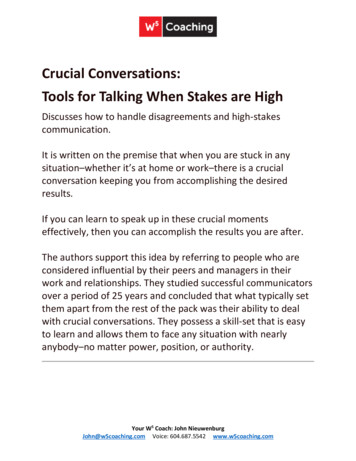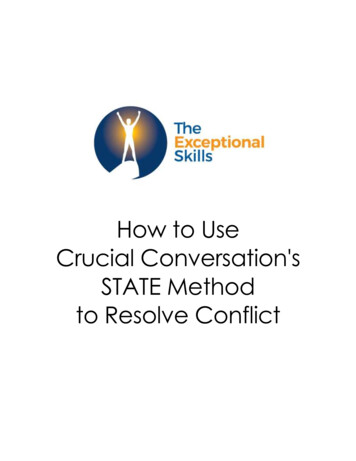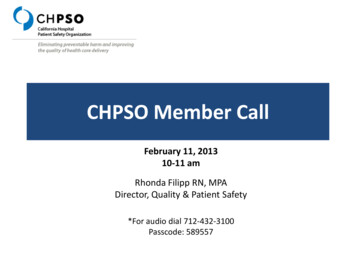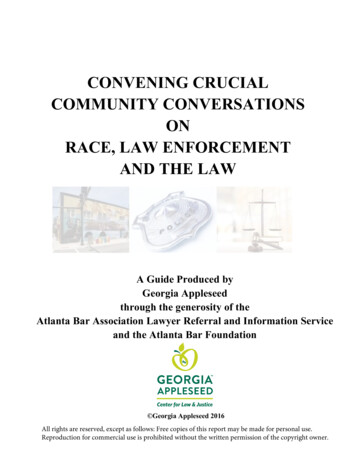
Transcription
CONVENING CRUCIALCOMMUNITY CONVERSATIONSONRACE, LAW ENFORCEMENTAND THE LAWA Guide Produced byGeorgia Appleseedthrough the generosity of theAtlanta Bar Association Lawyer Referral and Information Serviceand the Atlanta Bar Foundation Georgia Appleseed 2016All rights are reserved, except as follows: Free copies of this report may be made for personal use.Reproduction for commercial use is prohibited without the written permission of the copyright owner.
Table of ContentsINTRODUCTION . 4PURPOSE . 5EARLY STEPS . 6 Forming the Team . 6 Identify Purpose. 6 Identify Target Audience/Participants. 7 Select Meeting/Program Format Type . 8Format Type 1: Independent Facilitator. 8Format Type 2: Law Enforcement Lead . 9Format Type 3: Community Panel . 9 Tips for an Effective Meeting/Event . 9 Select Location/Venue .10 Select Tentative Date/Time . 11 Confirm participant/panelist availability & audiovisual needs . 11 Finalize Date/Time . 11PUBLICITY . 12 Save the Date . 12 Basic Notice/Invitation . 12 Electronic Communication/ Social media . 12 Other Publicity Vehicles . 13Local Print and Broadcast Media . 13Local Community/Outdoor Signage . 13Place of Worship Bulletin/Pulpit Call . 14PRE-EVENT: “WEEK OF” ACTIVITIES . 14 Remind Panel Members/Speakers . 14 Venue Visit . 14 Confirm food quantity and delivery time . 15 Confirm materials to distribute to attendees . 15“DAY OF” ACTIVITIES . 16 Arrive Early . 16 Georgia Appleseed 2016
Greeters . 16 Sign in . 16 Meeting Evaluation . 16 Clean Up. 17POST-EVENT: FOLLOW UP & “Continuing the Conversation” . 17WHAT IS NEXT FOR GEORGIA APPLESEED?. 17AppendicesAppendix A: Georgia Appleseed Report: Executive Summary including findings & recommendations. 18Appendix B: Atlanta Meeting Notice. 22Appendix C: Hiram Meeting Notice . 23Appendix D: Online Registration Options . 24Appendix E: Sign Up Form . 25Appendix F: Evaluation Form . 26 Georgia Appleseed 2016
CONVENING CRUCIAL COMMUNITY CONVERSATIONSONRACE, LAW ENFORCEMENT AND THE LAWA GuideProduced by Georgia Appleseedthrough the generosity of theAtlanta Bar Association Lawyer Referral Serviceand the Atlanta Bar FoundationINTRODUCTIONIn the Spring of 2015, the Georgia Appleseed Center for Law & Justice (“GeorgiaAppleseed”) began to seek the views of community members throughout Georgia---lawenforcement personnel, prosecutors, defense lawyers, neighborhood associations, faith leaders,political leaders, nonprofits and others -- to help in assessing the nature of police-communityrelations in our state and to seek recommendations for changes to law as well as policies andpractices that could improve or enhance them.This effort was in response to the highly publicized incidents of police encounters withcitizens—most often men and women of color—in Ferguson, North Charleston, Baltimore,Waller County (TX), and several Georgia communities (and the unrest that often followed).Georgia Appleseed brought to this effort a commitment to objective assessment, a deeprespect for the extraordinarily difficult, important and oftentimes dangerous service that lawenforcement personnel provide to our society and a belief that every Georgian must be affordedthe rights promised by the federal and state constitutions.The results of our research and interviews are summarized in a report issued in January2016 titled: Seeking the Beloved Community: Fostering Crucial Conversations about Race,Law Enforcement and the Law. The Report also recommended changes to law and policy inGeorgia.Shortly after releasing the Report, Georgia Appleseed worked with local law enforcementagencies to hold community meetings in the Metro Atlanta area, which have given us helpfulinsights as we continue to seek needed reforms.4 Georgia Appleseed 2016
PURPOSEThe purpose of this manual is to provide practical, “nuts and bolts,” advice to communityleaders who wish to work with local law enforcement to have their own “crucial conversations.”Georgia Appleseed hopes this manual will support positive community engagement with lawenforcement throughout the state.The need for meaningful, sustained community engagement is great. In the months sincewe issued the Report, we continue to hear, on the national and local news, about all too manyshootings of unarmed suspects, especially men and women of color, and retaliatory shootings ofpolice officers.This is a complex problem with no single, simple solution. We believe, however, that, inone sense, the beginning of the solution is fairly straight-forward, though admittedly easier saidthan done: community members and law enforcement personnel must find ways to have honestconversations – where they talk to – and listen to – and hear – each other. In doing so,meaningful solutions will present themselves. But how do we go about this straight-forward, buthard, process of sitting down and talking with each other? Especially when we don’t know eachother well and perhaps, as a result, do not have a high level of trust already in place? Thismanual is intended to help you figure out just how to take the first steps in having honest, crucial,conversations . . . in your own community.Georgia Appleseed wishes to thank the Atlanta Bar Association Lawyer Referral andInformation Service and the Atlanta Bar Association for its financial support of this Guide.5 Georgia Appleseed 2016
EARLY STEPS Forming the TeamIf you are an individual wanting to make change, we recommend that you reach out to alocal community organization that shares your community-minded vision and would be willingto take the lead on this effort, especially if you volunteer to help. We then recommend that theorganization form a small work group of one to three persons to plan and carry out thecommunity meeting. This team should then reach out to local law enforcement leaders tointroduce your desire to work with them in planning and holding a community meeting.The level of cooperation offered by law enforcement can vary. In one of our communitymeetings, the chief of police wanted to take a lead organizing role; in another, the meetingplanning and organizational effort was a joint undertaking; in another, the police agency wassupportive but deferred to Georgia Appleseed to assume the lead role.Whatever the roles of your organization and the participating law enforcement agency, itis important that the agency’s Chief appoint a “primary contact” who will be available to workwith you throughout the planning process. Sometimes this “primary contact” will be acommunity relations professional or public information officer. Identify PurposeA critical first step in the planning process is to identify the purpose of the communitymeeting. In its community meetings, Georgia Appleseed’s primary purpose was to inform thecommunity of the findings and recommendations contained in its January 2016 Report. A link tothe full Report, the executive summary, and a summary of recommendations is provided inAppendix A (Additional Resources).Community leaders who wish to include these recommendations as a focus of theircommunity meeting are very welcome to consult our report for conversation topics. GeorgiaAppleseed cannot participate in all such meetings, due to limited personnel, but GeorgiaAppleseed staff can review the Report’s findings and recommendations with you and can assistmeeting organizers in considering the most effective way to hold the meetings. (See the contactinformation provided at the very end of this manual to reach Georgia Appleseed if you havequestions.)6 Georgia Appleseed 2016
There are, of course, many important issues, other than those raised in the GeorgiaAppleseed Report, that could be discussed at your community meeting. Your organization andthe cooperating law enforcement agency should work together to be sure that the issues that aremost important to your community members are the ones that are covered at the communitymeeting. For example, your community might wish to understand and have input on issues suchas:--Law enforcement “use of force” policies--Community policing practices and policies--Law enforcement engagement with vulnerable populations (those who are mentally illand/or homeless, and those who are minors, etc.)--Citizen complaint procedures--Investigations following a “lethal use of force” incident--Access to information following a “lethal use of force” incidentWhile we believe that it is important to plan and prepare for a specific focus for themeeting, it is also important for the organizers to be flexible enough to recognize and adapt whenthe meeting participants are more interested in other issues. (See the discussion belowconcerning the “independent facilitator” meeting format.)We also know that sometimes it is better to have a meeting where there is no detailedagenda – the meeting purpose in that case would be to provide a safe space where people canspeak and be heard. Or, it may be that the meeting purpose is to have fun, while at the same timegive community and law enforcement personnel a chance to be together without any agenda atall. For instance, a social gathering, such as a reception or a picnic, during which communitymembers can interact informally with law enforcement personnel, may be a good first step inrelationship building. Identify Target Audience/ParticipantsYou will also need to think about your audience. Do you want to cast a wide net toinclude all community members with an effort to bring out a true “grass roots” population? Doyou want to engage community leaders (sometimes referred to as “grass tops)?” Do you want toencourage participation by younger people? As we discuss further below, determining yourdesired audience or community participants will likely influence other planning decisions.7 Georgia Appleseed 2016
Select Meeting/Program Format TypeJust as there is a number of different reasons to hold a community meeting, there are alsoa variety of meeting formats. In each of the community meetings facilitated by GeorgiaAppleseed, we were actively engaged in presenting the findings and recommendations of theReport and in talking with the meeting participants. Though these three meetings all shared asimilar purpose (to share information and receive feedback), we used three different formats.Format Type 1: Independent FacilitatorOne meeting reflected a very structured format and took advantage of the services of anindependent facilitator to help plan and run the meeting.Georgia Appleseed made apresentation on the Report and law enforcement officers from the cooperating departmentdiscussed their commitment to community policing. The facilitator then employed electronicdevices (note: cell phone audience feedback/polling “apps” are also available for a reasonablefee) to poll the participants as to the issues of most interest. The issues were then ranked andbreakout sessions were held to allow for more detailed small group discussion on the issues ofmost interest. The participants then reconvened to report on these discussions.While this approach can be highly effective, keep in mind there is typically a feeassociated with this sort of facilitation. Therefore, the engagement of an independent facilitatormay not be feasible for your organization unless you have funding for this expense. But do notgive up on this format. Be sure to ask all the members of your organization for their connectionswith a professional meeting facilitator who might be willing to volunteer his or her services. Thevolunteer must have excellent meeting facilitation experience. Audience members often havegreat emotion around the topic of police/community relations; an experienced facilitator willknow how to promote positive, constructive sharing of ideas and will also know how to keep thecommunication flowing so that no one person “takes over the microphone” to the exclusion ofeveryone else.The “independent facilitator” approach may present a challenge if the meeting attendanceis so large that you need to have small group discussions to increase the opportunities foreveryone to participate. In that case, in addition to the overall meeting facilitator, you will alsoneed volunteers to facilitate the small group discussions. If you have many volunteers who areable and willing to facilitate these break-out sessions, then this could be a good format for you.If your organization is small, then you may need to have limited registration to keep the numbersmanageable for your facilitator.8 Georgia Appleseed 2016
Finally, this approach may be “too structured.” At the meeting where we employed thisformat, it was apparent that the community members were very interested in discussingcommunity policing efforts with the law enforcement representatives present. This discussionwas a good use of time, but took time away from other items on the agenda, so that rest of themeeting felt rushed. As we mentioned earlier, we suggest that the need to retain the flexibility to“read the crowd” and respond accordingly should be considered before selecting this structuredapproach.Format Type 2: Law Enforcement LeadIn another meeting, the chief of a municipal police force of a suburban community madea brief presentation (about 20 minutes) about his department and about the reforms he wasputting in place to respond to community needs. Then he opened the floor to questions from thecommunity members present on any issues they wished to discuss. No topics were off limits.The conversation was positive and respectful, and the event was considered a success, but thechief did have to have a high degree of confidence in his own relationship with his community toembrace this community meeting format. Not every local Chief of Police or local Sheriff willfeel comfortable in leading such an open-ended conversation, but if you live in a communitywhere local law enforcement offers to take the lead in the conversation, you are encouraged totake him or her up on the offer, at least for the first meeting.Format Type 3: Community PanelThe third format used in our community meetings was that of a community panel. Thismeeting was held in partnership with the public safety department of a Metro Atlanta areacollege. Working with Georgia Appleseed, the college police chief enlisted several communitymembers to serve on a panel. The panel members included law enforcement personnel from thecollege and nearby police jurisdictions, students, a faculty member with expertise on AfricanAmerican studies, and a pastor from a local church. Each panel member made a briefpresentation. The floor was then opened for questions and comments. Tips for an Effective Meeting/EventThis could be a great opportunity to start authentic communication, but all participantsmust be advised, at the beginning of the meeting, in the presence of all in attendance, thatauthentic, civil conversation is to be the goal and that one side cannot monopolize themicrophone to the exclusion of others in the room. Further, all participants need to commit to9 Georgia Appleseed 2016
certain “ground rules” to insure that all have a chance to be heard and respond to the issuesraised. Common ground rules include the following: Listen respectfullySpeak one person at a timeKeep comments briefNo personal attacksTurn off cell phones (or turn to vibrate mode) Select Location/VenueThe next step is to identify the location of the planned meeting. As community members,you will likely know what options are available for these types of meetings. You will want tohave an estimate in mind of the number of people you expect will attend so that you can identifya site that can accommodate that number. The meetings can be held, for example, in a local faithcommunity's fellowship hall, in community centers, or in college or high school auditoriums.Generally, such meeting space is available at low or no cost, but you should check with thevenue’s administrator to confirm this.Plan on arriving at the meeting site at least 60 to 90 minutes before the scheduled starttime on the day of the meeting to be sure it is set up properly . . . or to handle the set up yourself.You need to confirm that you will have access to the room that far in advance of the start time.Will the door be unlocked? Will someone be there to let you in? You will want to understandhow and when the meeting room will be set up if it is not an auditorium style facility. Will thelocation’s staff handle room set up or will you be responsible? If food is being provided, wherecan it be served? If audio visual (AV) equipment is necessary, is it available at the venue or doyou have to bring your own microphone/computer/slide screen/PowerPoint projector/etc. If so,does the site offer (require) the services of its AV technician?A few further words about food. Try to have it! Being able to advertise thatrefreshments (or a meal) will be offered often provides a remarkable boost to attendance. Whilethere can be a cost involved, this is a great opportunity to engage local businesses in thisimportant topic by seeking in-kind donation of food and/or beverages.It is important that your venue be accessible to everyone, regardless of their ability to getaround. All members of the community/audience must feel comfortable in the location youselect for your meeting.10 Georgia Appleseed 2016
It is also important to note that, while we have presented the foregoing steps as separateand independent, they are actually closely related. In other words, the meeting’s purpose, formatand location are all dependent on the selected target audience. The reverse is also true. Forexample, you may want to engage a broad cross section of the “grassroots” members of thecommunity in the meeting, which will likely drive certain decisions about meeting format andlocation. You may, on the other hand, want to engage leaders of certain community groups(“grass tops”), which might drive different organizational choices. Select Tentative Date/TimeWe recommend that the planning process for a community meeting begin at least 90 daysbefore the anticipated meeting date to allow time for planning and adequate marketing/publicity.Again, community organizers probably know the best days of the week and times of dayto assure the greatest number of attendees. The work group and the law enforcement partner willneed to decide on the length of the meeting depending on the purpose and format decisions.In identifying the tentative timing, the organizers should confirm the availability of theselected site and also carefully check school and community event calendars so that the meetingdoes not conflict with other events likely to draw heavy community participation. Confirm participant/panelist availability & audiovisual needsOnce the tentative date is selected, the organizers should check with participating lawenforcement partners and also with identified panel participants (if the panel format option hasbeen selected) to confirm availability. If you are trying to confirm several people’s schedules,one easy-to-use and free online scheduling tool is called Doodle: www.doodle.com.During this conversation, the organizers should also determine if the participants plan touse a Power Point or other presentation format that will require AV support on the day of themeeting. Finalize Date/TimeThe organizers can now communicate the confirmed meeting details to the meetingparticipants and begin the process of publicizing the event.11 Georgia Appleseed 2016
PUBLICITY Save the DateIf you know the details of your event early, you may want to send out a brief “save thedate” notice. You can do this electronically, by email or social media, or you can send the “savethe date” to local churches, synagogues, mosques, or other organizations to ask them to add it totheir own newsletters or bulletins. Basic Notice/InvitationExamples of meeting notices/invitations used by Georgia Appleseed for its communitymeetings are attached in Appendices B and C. The notices should, of course, inform therecipients of the date, start time, duration and location of the meeting. Directions to the meetingsite and instructions about parking are important. If food is being provided, that informationshould be included.In addition to this important basic information, you should also try to “set the tone” forthe meeting as one where collaborative crucial conversations will take place. All participantsshould be urged to be candid and you should certainly anticipate that views will often beexpressed with passion. You should encourage participants to be willing to listen to and respectthe views of all who are in the meeting.To help increase attendance, you may want to ask that participants register in advance.Preregistration can be by telephone, by email or by use of an online registration form. (Optionsare available to view in Appendix D.) If you explain that preregistration will help organizers besure to have enough food/snacks/beverages on hand, then the public will probably cooperate withyour request.You should be aware, however, that often many individuals who register do not attendand many in attendance do not register in advance. Electronic Communication/ Social mediaThe easiest, most popular and most cost effective method for getting the word out aboutyour meeting is through electronic communication including e-mails and social media outlets(i.e., Facebook and Twitter). The community organizations engaged in planning the meeting aswell as the cooperating police agencies will likely have email lists that can be used to inform12 Georgia Appleseed 2016
potential participants of the event. Other community organizations and local churches,synagogues, and mosques will also often be willing to “spread the word.” Be creative when itcomes to letting the community know about your event. You want them to know it will beimportant that they make the time to be there, but be sure you keep the tone of yourcommunications about the meeting consistent with the tone you expect to maintain throughoutthe meeting. Other Publicity VehiclesWhile electronic communication is important, you should employ other ways ofcommunication to encourage participation. After all, not all members of your potentialparticipants may have ready access to the Internet. If your organization has lots of contacts withhouses of worship in your community, you might consider if members of your work group mightask for a few minutes during “community prayers” to let the congregation know about theupcoming event and ask for their attendance. Or you may see if the local parent/teacher meetinghas time to allow you to personally extend an invitation to all parents to join in the communitymeeting. You know your community best and know all the different ways to reach out. All werecommend is that you use your creativity to make sure that as many people as possible knowabout this opportunity to hear and be heard.Local Print and Broadcast MediaYou probably know which local newspapers may be willing to publish information aboutcommunity events. While the major metropolitan dailies may not be readily accessible, localweekly newspapers, or neighborhood online publications such as “The Patch,” may be more thanhappy to do a story on an upcoming event.In addition, organizers (or perhaps their teenage children) will know what local radiostations are popular with community members so that they can be approached about publicservice announcements.Local Community/Outdoor SignageMany local municipalities maintain signs on key access roads or near city governmentcenters that can be used to advertise community events. Also, your selected site may haveoutside signs that you could use.13 Georgia Appleseed 2016
Place of Worship Bulletin/Pulpit CallLocal places of worship may be willing to include a notice of the meeting in their printedbulletins for a week or two in advance of the meeting. Even more effective is a direct call fromthe pulpit encouraging parishioners to attend.PRE-EVENT: “WEEK OF” ACTIVITIES Remind Panel Members/SpeakersAbout 10 days before the community meeting, you should reconfirm participation withall of the panel members (if that format option is chosen) or other speakers reminding them oftheir agreement to participate in your community meeting and all the meeting details. If any areplanning on making an electronic presentation, they should send a copy to the organizing teamby email or by delivering a “thumb drive.” This way, you can be sure that all presentations areloaded onto the computer and are “working” before the event, which should minimize “technicaldifficulties” that could delay your meeting. Venue VisitUnless your organizing team is very familiar with the site for the community meeting, itwill be important for the organizers to arrange for a visit to the site a few days before themeeting. This will allow the team to be familiar with the room size and shape and confirm thedesired seating set up. This will be especially true if you have requested participants to registerso that you have a reasonable estimate of the anticipated turnout. You can also determine wherefood and beverages may be served and become familiar with the parking options, rest roomlocations, etc. If the building offers any special access routes for disabled participants,
manual is intended to help you figure out just how to take the first steps in having honest, crucial, conversations . . . in your own community. Georgia Appleseed wishes to thank the Atlanta Bar Association Lawyer Referral and Information Service and the Atlanta Bar Association for its f
